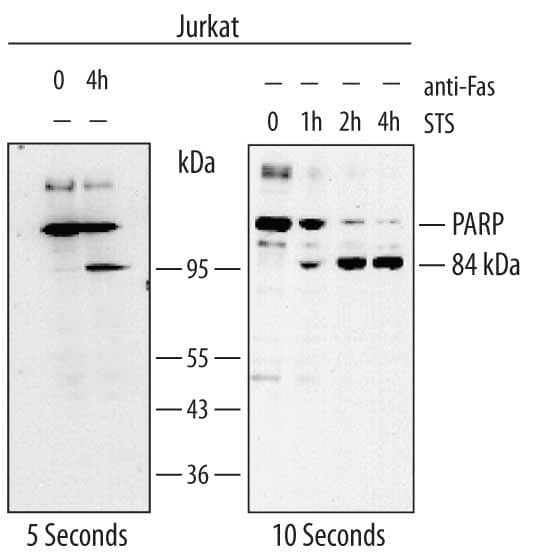Human/Mouse PARP Antibody
Bio-Techne includes R&D Systems | Catalog # MAB600

Discontinued Product
MAB600 has been discontinued and is replaced by
AF-600-NA.
Key Product Details
Species Reactivity
Validated:
Human, Mouse
Cited:
Human, Mouse
Applications
Validated:
Western Blot
Cited:
Immunocytochemistry, Immunohistochemistry, Western Blot
Label
Unconjugated
Antibody Source
Monoclonal Rat IgG2A Clone # 53015
Product Summary for Human/Mouse PARP Antibody
Immunogen
E. coli-derived recombinant mouse PARP
Val71-Pro329
Accession # NP_031441
Val71-Pro329
Accession # NP_031441
Specificity
Detects human and mouse PARP in Western blots.
Clonality
Monoclonal
Host
Rat
Isotype
IgG2A
Scientific Data Images for Human/Mouse PARP Antibody
Detection of Human PARP by Western Blot.
Western blot shows lysates of Jurkat human acute T cell leukemia cell line untreated (-) or treated with anti-Fas and 1 µM staurosporine (STS) for 0 to 4 hours (h; as indicated). PVDF membrane was probed with 0.6 µg/mL of Rat Anti-Human/Mouse PARP Monoclonal Antibody (Catalog # MAB600) followed by HRP-conjugated Anti-Rat IgG Secondary Antibody (Catalog # HAF005). Specific bands were detected for PARP at approximately 116 kDa and the 84 kDa product of PARP cleavage (as indicated). This experiment was conducted under reducing conditions and using Immunoblot Buffer Group 2.Detection of Mouse PARP by Western Blot.
Western blot shows lysates of NIH-3T3 mouse embryonic fibroblast cell line treated with 1 µM staurosporine (STS) for 0 to 4 hours (h; as indicated). PVDF membrane was probed with 0.6 µg/mL of Rat Anti-Human/Mouse PARP Monoclonal Antibody (Catalog # MAB600) followed by HRP-conjugated Anti-Rat IgG Secondary Antibody (Catalog # HAF005). Specific bands were detected for PARP at approximately 116 kDa and the 60-70 kDa bands generated with staurosporine treatment (as indicated). This experiment was conducted under reducing conditions and using Immunoblot Buffer Group 2.Detection of Human PARP by Western Blot
The treatment of n-BP rescued the progression of QA-induced excitotoxicity in SCA3 PPs. The control and/or SCA3 PPs were treated with or without QA (1 μM) in the presence of n-BP (0, 10, 20, and 40 μg/mL) for 12 h. (A) Images of QA-treated SCA3 PPs in the presence of BP (40 μg/mL). (B) Confocal images of poly Q localization in BP (40 μg/mL)-treated SCA3 PPs in the presence of QA (1 um). When compared with Figure 2C, 40 μg/mL of n-BP prevented the amounts of colocalized polyQ in the cell nucleus of PPs. The distribution of polyQ in the nucleus is indicated by white arrowheads. Scale bar = 100 μm; (C) protein analysis of wild-type, mutant ATXN3 and its proteolytic fragment in cell lysates of control and SCA3 PPs, as assessed by immunoblots. Soluble, soluble protein; Insoluble, insoluble protein; (D,E) representative immunoblot of control and cleaved PARP1 in cell lysates of control and SCA3 PPs, as assessed by immunoblots. The HDAC2 were used as loading controls. The quantification from three independent images is presented as the means ± standard deviation. t(4) = 2.824, p < 0.05, for lane 1 vs. lane 2; t(4) = 5.613, p < 0.01, for lane 1 vs. lane 3; t(4) = 3.522, p < 0.05, for lane 1 vs. lane 4; (F) the quantification result of calcium concentration in SCA3 PPs, as assessed by Fura-2 indicator. Cells were treated with QA (1 μM) in the presence of n-BP (0, 10, 20, and 40 μg/mL). Data are presented as the means ± standard deviation. t(4) = 2.95, p < 0.05; (G) the calpain activity in control and SCA3 PPs cell lysates, as assessed by ELISA assay. The quantification results from three independent replicates are presented as the means ± standard deviation. t(4) = 3.27, p < 0.05, for lane 3 vs. lane 4; t(4) = 17.55, p < 0.01, for lane 3 vs. lane 5; t(4) = 9.019, p < 0.01, for lane 3 vs. lane 6. (H) Protein analysis of calpain 1, calpain 2 and calpastatin in cell lysates of SCA3 PPs, as assessed by immunoblots. Cells were treated with or without QA (1 μM) in the presence of n-BP (0, 10, 20, and 40 μg/mL). *, p < 0.05; **, p < 0.01. Image collected and cropped by CiteAb from the following publication (https://pubmed.ncbi.nlm.nih.gov/35163312), licensed under a CC-BY license. Not internally tested by R&D Systems.Applications for Human/Mouse PARP Antibody
Application
Recommended Usage
Western Blot
0.6 µg/mL
Sample: Jurkat human acute T cell leukemia cell line treated with anti-Fas and staurosporine (STS) and NIH‑3T3 mouse embryonic fibroblast cell line treated with staurosporine (STS)
Sample: Jurkat human acute T cell leukemia cell line treated with anti-Fas and staurosporine (STS) and NIH‑3T3 mouse embryonic fibroblast cell line treated with staurosporine (STS)
Please Note: Optimal dilutions of this antibody should be experimentally determined.
Reviewed Applications
Read 1 review rated 5 using MAB600 in the following applications:
Formulation, Preparation, and Storage
Purification
Protein A or G purified from hybridoma culture supernatant
Reconstitution
Reconstitute at 0.5 mg/mL in sterile PBS. For liquid material, refer to CoA for concentration.
Formulation
Lyophilized from a 0.2 μm filtered solution in PBS with Trehalose. *Small pack size (SP) is supplied either lyophilized or as a 0.2 µm filtered solution in PBS.
Shipping
The product is shipped at ambient temperature. Upon receipt, store it immediately at the temperature recommended below. *Small pack size (SP) is shipped with polar packs. Upon receipt, store it immediately at -20 to -70 °C
Stability & Storage
Use a manual defrost freezer and avoid repeated freeze-thaw cycles.
- 12 months from date of receipt, -20 to -70 °C as supplied.
- 1 month, 2 to 8 °C under sterile conditions after reconstitution.
- 6 months, -20 to -70 °C under sterile conditions after reconstitution.
Background: PARP
Long Name
Poly [ADP-ribose] Polymerase
Alternate Names
ADPRT, PARP1, PPOL
Gene Symbol
PARP1
UniProt
Additional PARP Products
Product Documents for Human/Mouse PARP Antibody
Product Specific Notices for Human/Mouse PARP Antibody
For research use only
